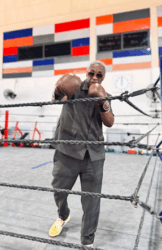By Bernard Kelvin CLIVE
As usual, I was at home on a Saturday morning, balancing chores with preparations for the week ahead. My schedule included various training sessions and speaking engagements. While organizing my notes for a personal branding workshop aimed at young entrepreneurs. I began observing my children as they played. Their natural communication flow struck me, and it became clear that we often lose these innate skills as we grow older. Here are some key observations and lessons we can learn from children to enhance our personal brands. public speaking and communication skills.
Eye Contact
One of the first things I noticed was how my children, all under six years old, maintained eye contact while speaking or playing. This came naturally to them; no one taught them to do this. Eye contact is necessary for effective communication because it allows you to connect with your audience. As adults, we frequently forget this basic but effective technique.
Maintaining eye contact becomes more difficult as we age due to societal expectations and the fear of being judged. However, making eye contact indicates confidence, honesty, and involvement. It enables speakers to measure audience reactions and tailor their speech accordingly. To strengthen your eye contact in presentations, try speaking to a mirror or filming yourself. Focus on different sections of the audience, making brief eye contact with individuals to create a sense of personal connection.
Use of Gestures
Children use gestures instinctively. They point, wave, and use their hands to express themselves. These gestures help them communicate more effectively and clearly. As public presenters, using gestures can assist us to stress our remarks and maintain the audience’s attention.
Gestures give visual appeal to your message, making it more dynamic and memorable. They can emphasize key ideas, demonstrate concepts, and convey feelings. For example, when describing something enormous, spread your arms wide to assist the listener in visualizing the magnitude. To be effective, your motions should be natural and pertinent to your message. Avoid overusing gestures, as they can be distracting. Practice in front of a mirror or with a trusted buddy to perfect your motions and incorporate them into your communication style.
Physical Touch
Occasionally, my children would use touch to gain each other’s attention, like holding hands or gently tapping one another. While not always acceptable in public speaking situations, this highlights the significance of utilizing a variety of strategies to interest our audience. In a figurative sense, we can “touch” our audience by addressing them directly and personalizing our message.
Physical touch in conversation can convey warmth and trust. While direct touch is rarely possible in public speaking, you can create a comparable impression with your demeanor and approach. To build a sense of community with your audience, use words like “we” and “us.” Tell personal stories that make people feel something. Share personal stories or anecdotes that elicit an emotional response. This strategy helps to establish rapport and makes your audience feel appreciated and connected to your message.
Asking Questions
Children are naturally curious and ask questions repeatedly until they get a response. This persistence ensures their queries are addressed. As speakers, we should encourage interaction by asking rhetorical questions or inviting the audience to participate. This keeps them engaged and ensures our message is received.
Questions are a great tool in public speaking. They provoke thought, stimulate interest, and encourage engagement. Rhetorical questions can highlight key points and make the audience reflect on the topic. Direct questions can invite audience participation, creating an interactive atmosphere. For example, asking, “How many of you have faced this challenge?” can prompt a show of hands and make the audience feel involved. Use questions strategically to guide your narrative and reinforce your message.
Animated Expression
When children communicate, their whole body is involved. They are animated, their faces light up, and their excitement is palpable. This kind of energy can be incredibly effective in public speaking. We can make our message more memorable by being expressive and passionate about our topic.
The animated expression conveys enthusiasm and passion, making your message more compelling. Facial emotions, body gestures, and voice variation all add to this dynamic performance. Smiling, raising your eyebrows, and widening your eyes can help emphasize your points and show your emotions. Changing your tone and pace can keep the audience interested and highlight important parts of your speech. So practice in front of a mirror or record yourself to see where you can be more expressive and enthusiastic.
Reliving Our Natural Communication Skills
Reflecting on my observations, it became evident that social pressures, fear, and anxiety often cause adults to lose the natural communication skills they exhibited as children. As public speakers, we can enhance our effectiveness by consciously reintegrating these behaviors. Here are practical steps to help you revive these natural skills:
- Practice Mindfulness: Pay attention to your body language, eye contact, and gestures during conversations and presentations. Mindfulness can help you become more aware of your communication style and make the necessary changes.
- Seek input: Request feedback from friends, family, and colleagues. Constructive criticism can provide useful information about your abilities and opportunities for progress.
- Observe and Learn: Pay attention to how skilled presenters employ eye contact, gestures, and facial expressions. Learn from their techniques and apply them to your style.
- Engage in Play: Spend time with children and observe their communication methods. Engage in playful activities that encourage expressive and dynamic interactions. This can help you reconnect with your natural communication abilities.
- Rehearse Regularly: Practice your speeches and presentations regularly. Repetition builds confidence and allows you to refine your delivery, making it more natural and effective.
No doubt observing children can teach us a lot about effective communication. Their natural abilities to maintain eye contact, use gestures, engage physically, ask questions, and express themselves animatedly are skills that we can harness to become better public speakers. Our communication can be enhanced and our audience can feel more connected when we revisit these innate behaviors. So next time you prepare for a speech or presentation, take a moment to observe how children communicate and let those lessons guide you.
Key Take-home Points
- Eye Contact: Establish a connection with your audience by maintaining eye contact.
- Use of Gestures: Emphasize points and keep the audience well-engaged with natural gestures.
- Physical Touch (Engagement): Engage your audience directly, making your message feel personal.
- Asking Questions: Encourage interaction by asking questions and inviting participation.
- Animated Expression: Use your whole body to express excitement and passion, making your message more memorable.
I’m confident that by observing and learning from children, we can rekindle our natural communication skills and become more effective public speakers. Relive those childhood behaviors, and let your communication flow naturally to drive home your message. If you enjoyed this episode, reflect on these five pointers and incorporate them into your public speaking practice. The best is yours!
Bernard is a leading authority on personal branding and digital book publishing in Africa. He is also the host of the highly-ranked Career & Business Podcast, where he shares his insights on branding and life. As a brand strategist at BKC Consulting, he runs the monthly Branding & Publishing Masterclass, helping individuals take their personal and professional brands to new heights. To learn more about Bernard and his work, visit www.BKC.name.











